The derailment of the Mysuru-Darbhanga Bagmati Express on Friday night near Chennai was a harrowing incident, leaving passengers injured and disrupting rail traffic. While initial investigations focused on the possibility of sabotage or a terror angle, the National Investigation Agency (NIA) has ruled these out, pointing towards technical failure as the probable cause. This article delves into the incident, examining the events leading up to the derailment, the agency’s investigations, and the response from the Southern Railways.
Technical Failure: The Likely Culprit
The NIA, after conducting a thorough investigation, concluded that technical issues were the most likely cause of the derailment. There was no evidence to support any theory involving terror or sabotage, and the agency found no intelligence input indicating a planned attack. While their involvement in the investigation is standard procedure, their findings reinforce the initial assessment that the accident was not deliberate.
Lack of Intelligence Inputs and Absence of Conspiracy
The NIA’s involvement was prompted by a routine protocol that requires them to investigate any major train derailment. However, their investigation yielded no evidence suggesting any terrorist plot or deliberate sabotage. This means there was no prior intelligence or credible information that indicated any threat or attempted disruption of rail operations.
The Train’s Path and the Accident Sequence
Southern Railway General Manager RN Singh explained that the Mysuru-Darbhanga Express was mistakenly routed onto a loop line where a stationary goods train was parked. The loop line is typically used for passing trains, allowing one train to proceed while another waits, but it was not the intended route for the passenger train.
Signals Followed, But a Deviation Occurred
According to Singh, the train driver adhered to the signal instructions, indicating that the train should have proceeded along the main line. However, despite receiving the correct signal, the train deviated onto the loop line and collided with the stationary goods train. This deviation is a significant point of investigation, as it requires understanding why the train did not follow its designated route.
Impact and Damage
The collision resulted in the derailment of 12 coaches from the passenger train. While thankfully no fatalities were reported, the accident left 19 passengers injured, with three in critical condition. The force of the collision significantly impacted both trains, and restoration work at the accident site disrupted services for several other trains, including the Dhanbad-Alappuzha Express and the Jabalpur-Madurai Superfast Special Train.
Response and Investigations
Southern Railway officials swiftly responded to the accident, immediately transporting the injured to nearby hospitals. The agency emphasized the lack of casualties as a fortunate outcome. Following the incident, a thorough investigation was launched to determine the exact cause of the derailment.
Focus on Understanding the Deviation
The investigation will likely center around understanding why the passenger train, despite receiving the correct signal, deviated onto the loop line. Factors to be explored include possible signaling system malfunctions, human error, or any environmental influences that may have impacted train operations.
Take Away Points
The Mysuru-Darbhanga Bagmati Express derailment serves as a stark reminder of the importance of safety measures and stringent maintenance in the railway system. The incident underscores the significance of continuous vigilance and constant improvement in operational procedures. Here are key takeaways from the incident:
- Prioritizing Technical Safety: Technical failures can have disastrous consequences and therefore demand constant vigilance and rigorous maintenance to prevent such incidents in the future.
- Reviewing Signaling Systems: This incident highlights the need for thorough reviews of the railway signalling system to ensure accuracy and prevent instances where trains deviate from their intended routes.
- Human Factor Evaluation: While the investigation continues, evaluating potential human error in train operations is crucial to learn from mistakes and improve safety protocols.
- Strengthening Safety Measures: Railway authorities need to assess and strengthen safety measures across the network to minimize the risk of derailments and ensure the well-being of passengers.









